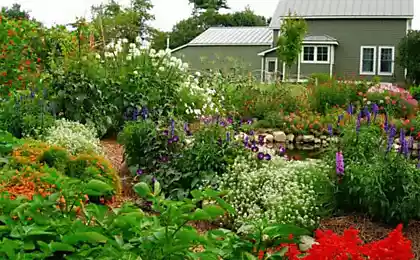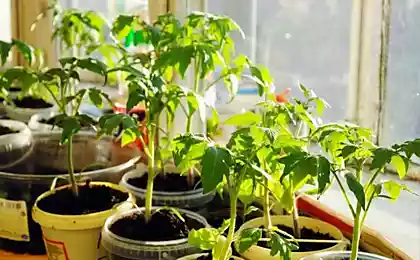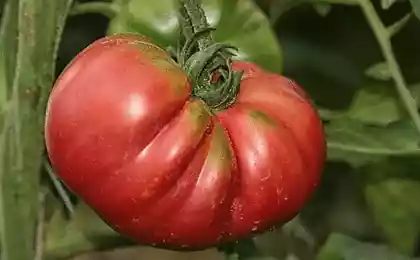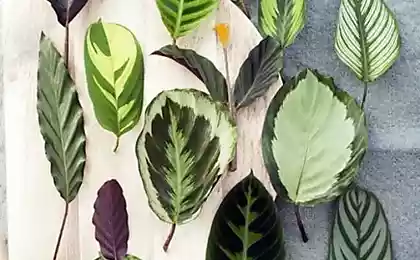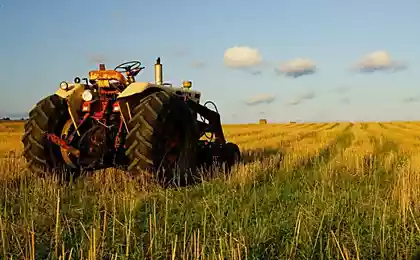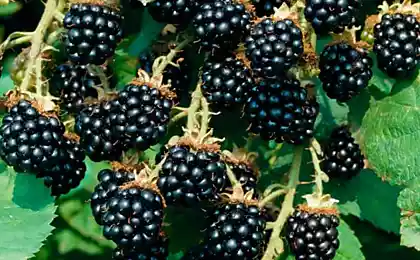562
7 ways to use comfrey in the garden to increase crop yield and quality
Comfrey is an indispensable plant for the garden. It attracts pollinators and beneficial insects, has value as a medicinal plant, enriches the soil with nutrients.
Star permaculture garden
If you had to choose a character permaculture garden, they probably would have been comfrey. This is a very powerful, fast-growing, undemanding plant, possessing all the qualities required for a permaculture garden.
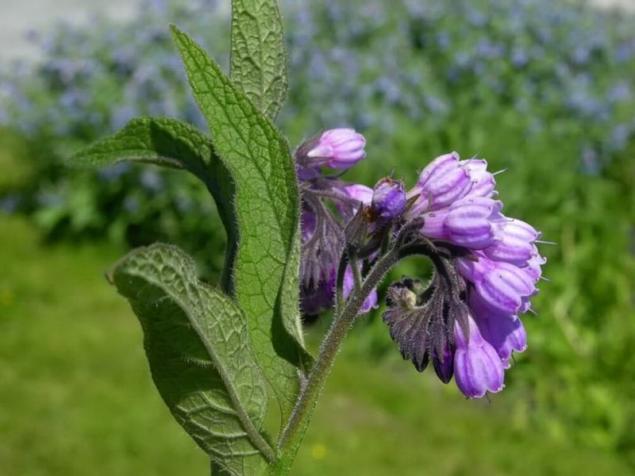
The flowers of the plant attract pollinators, large leaves provide a habitat for beneficial insects. But it also has medicinal properties.
Due to the long roots of the plant collects nutrients deep in the ground, accumulating in the leaves of nitrogen, phosphorus, potassium, chloride, potassium and calcium.
Seven ways you can use these properties of comfrey to enrich the soil with nutrients, increase crop yield and quality.
1. The compost and accelerate its maturation using comfrey
Cut the leaves of comfrey contain a lot of nitrogen, making them an excellent bioactivator compost. If you have a lot of comfrey leaves, then an effective way to balance the ratio of carbon and nitrogen and to give impetus to expansion would be the inclusion in compost of this plant.
It is simple, not time-consuming action like chewing food and helps the beneficial microorganisms from the compost heap work faster.
The resulting compost will have a higher nutrient content.
2. Fertilizer from comfrey
Green manure can be an alternative or Supplement to animal manure.
If you compare the fertilizer from comfrey and chicken manure, it appears that they are relatively close values of nitrogen, phosphorus and potassium, and the content of nitrogen and potassium fertilizer from comfrey surpasses even chicken manure.
Ordinary compost has a much lower content of these substances, from which it is clear that compost is more useful as a soil amendment containing beneficial micro-organisms, and not as fertilizer.
Comfrey can also be added to the soil in early spring, at least two weeks before planting.
Comfrey does not resume from hibernation until late March or April depending on your location, so it is impossible to obtain the green leaves of comfrey. In this case, you can use the powder of the leaves of the plant, harvested in summer and autumn.
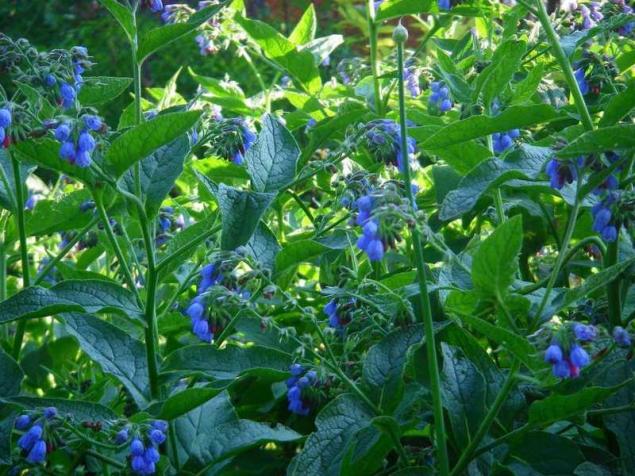
3. The powder of comfrey
Have on hand dried comfrey is often very convenient. It is possible to make an ointment for cuts, scrapes, stings, bruises, inflamed joints and other external ailments. Dried and powdered comfrey (root and leaves) can also be used to improve soil in the garden.
To make the powder of the comfrey is not difficult.
The advantage of this powder is that it can be used in early spring, before the plants comfrey woke up after hibernation and their leaves. The powder decomposes at a faster rate than fresh leaves, which is also better for the garden in the spring.
4. As the comfrey roots and improves the soil
Comfrey roots penetrate the ground on 1.5-3 meter, breaking the heavy clay and creating channels for aeration and better water absorption. Over time, his decaying leaves and roots to fertilize the soil. This double action of the decaying leaves and roots can help to improve marginal land. Because comfrey prefers rich soil, help him by adding to the soil a shovelful of manure or compost.
5. Improved growth of seedlings and seedlings with comfrey
Young perennial plants (fruit trees, berry bushes, asparagus, greens, etc.) and seedlings of vegetable crops (tomatoes, peppers, cucumbers, zucchini, etc.) will benefit the breeding ground of comfrey.
While planting these plants, bury a few leaves of comfrey (but not the flowering stems) under each plant. Upon decomposition, leaves of the plant necessary nutrients come to the young plants and help them grow strong and resistant to pests and diseases.
6. Liquid fertilizer from comfrey
A compost infusion is a great way to provide good food rooted plants. It is prepared by steeping fresh plant material in water for a certain period of time, straining the liquid and use it for watering plants that need fertilizing in mid season.
Additional nitrogen in the compost tea from comfrey will help the growth of plants, and potassium stimulates flowering and vigorous growth of perennial plants and maturation of fruits and vegetables.
A compost infusion of comfrey is not recommended for young plants.
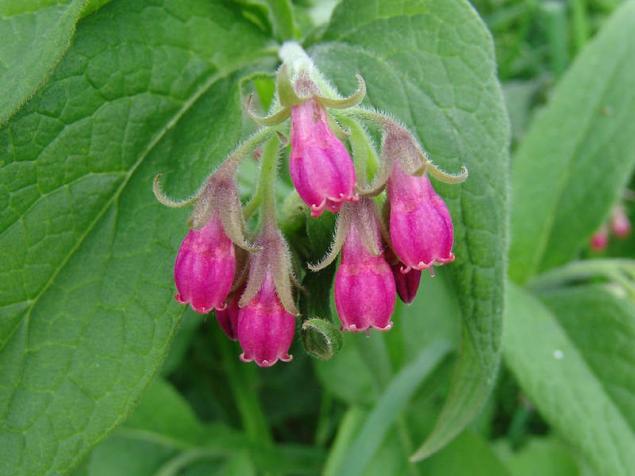
7. Mulch of comfrey
In General, mulching is a great way to protect the soil and prevent erosion.
Mulching the plant will help retain moisture and protect beneficial organisms in the soil.
Mulch of comfrey slowly releases nutrients, it is good to use under perennial crops.
Also interesting: - friendly products for families: how to start organic farming in the garden
As cinnamon will help to solve problems in the garden
As you can see, growing comfrey is of great value for garden, reducing fertiliser costs and assuring healthy plants and a great harvest.published
Source: vk.com/permakultur?w=wall-6222142_83038
Star permaculture garden
If you had to choose a character permaculture garden, they probably would have been comfrey. This is a very powerful, fast-growing, undemanding plant, possessing all the qualities required for a permaculture garden.

The flowers of the plant attract pollinators, large leaves provide a habitat for beneficial insects. But it also has medicinal properties.
Due to the long roots of the plant collects nutrients deep in the ground, accumulating in the leaves of nitrogen, phosphorus, potassium, chloride, potassium and calcium.
Seven ways you can use these properties of comfrey to enrich the soil with nutrients, increase crop yield and quality.
1. The compost and accelerate its maturation using comfrey
Cut the leaves of comfrey contain a lot of nitrogen, making them an excellent bioactivator compost. If you have a lot of comfrey leaves, then an effective way to balance the ratio of carbon and nitrogen and to give impetus to expansion would be the inclusion in compost of this plant.
- To speed decomposition, chop the comfrey leaves with garden shears or other means. Add a small amount of water and work into a rich green mass for a minute or two to form a paste. Add more water, then pour the solution onto the compost pile.
It is simple, not time-consuming action like chewing food and helps the beneficial microorganisms from the compost heap work faster.
The resulting compost will have a higher nutrient content.
2. Fertilizer from comfrey
Green manure can be an alternative or Supplement to animal manure.
If you compare the fertilizer from comfrey and chicken manure, it appears that they are relatively close values of nitrogen, phosphorus and potassium, and the content of nitrogen and potassium fertilizer from comfrey surpasses even chicken manure.
Ordinary compost has a much lower content of these substances, from which it is clear that compost is more useful as a soil amendment containing beneficial micro-organisms, and not as fertilizer.
- When using comfrey as a green manure in the autumn, add the chopped leaves to garden soil. Gently mix the leaves with the top layer of the soil using forks. The spring foliage is mainly decompose and enrich the soil with nutrients.
Comfrey can also be added to the soil in early spring, at least two weeks before planting.
Comfrey does not resume from hibernation until late March or April depending on your location, so it is impossible to obtain the green leaves of comfrey. In this case, you can use the powder of the leaves of the plant, harvested in summer and autumn.

3. The powder of comfrey
Have on hand dried comfrey is often very convenient. It is possible to make an ointment for cuts, scrapes, stings, bruises, inflamed joints and other external ailments. Dried and powdered comfrey (root and leaves) can also be used to improve soil in the garden.
To make the powder of the comfrey is not difficult.
- Use the dryer or dry the leaves in a well-ventilated place. Separate the stems, then use a blender or coffee grinder to make powder. Store in an airtight container. For garden needs dry leaves you can just grind gloved hands.
The advantage of this powder is that it can be used in early spring, before the plants comfrey woke up after hibernation and their leaves. The powder decomposes at a faster rate than fresh leaves, which is also better for the garden in the spring.
4. As the comfrey roots and improves the soil
Comfrey roots penetrate the ground on 1.5-3 meter, breaking the heavy clay and creating channels for aeration and better water absorption. Over time, his decaying leaves and roots to fertilize the soil. This double action of the decaying leaves and roots can help to improve marginal land. Because comfrey prefers rich soil, help him by adding to the soil a shovelful of manure or compost.
5. Improved growth of seedlings and seedlings with comfrey
Young perennial plants (fruit trees, berry bushes, asparagus, greens, etc.) and seedlings of vegetable crops (tomatoes, peppers, cucumbers, zucchini, etc.) will benefit the breeding ground of comfrey.
While planting these plants, bury a few leaves of comfrey (but not the flowering stems) under each plant. Upon decomposition, leaves of the plant necessary nutrients come to the young plants and help them grow strong and resistant to pests and diseases.
6. Liquid fertilizer from comfrey
A compost infusion is a great way to provide good food rooted plants. It is prepared by steeping fresh plant material in water for a certain period of time, straining the liquid and use it for watering plants that need fertilizing in mid season.
Additional nitrogen in the compost tea from comfrey will help the growth of plants, and potassium stimulates flowering and vigorous growth of perennial plants and maturation of fruits and vegetables.
A compost infusion of comfrey is not recommended for young plants.
- To do this infusion complete any container halfway with fresh comfrey leaves, cover with water, cover and leave to vymachivanija for 3 to 5 days. Before use, strain the liquid and dilute in the ratio of 1 liter of infusion in 4 liters of water.

7. Mulch of comfrey
In General, mulching is a great way to protect the soil and prevent erosion.
Mulching the plant will help retain moisture and protect beneficial organisms in the soil.
Mulch of comfrey slowly releases nutrients, it is good to use under perennial crops.
Also interesting: - friendly products for families: how to start organic farming in the garden
As cinnamon will help to solve problems in the garden
As you can see, growing comfrey is of great value for garden, reducing fertiliser costs and assuring healthy plants and a great harvest.published
Source: vk.com/permakultur?w=wall-6222142_83038
Arenation: treatment of hot sand and joint diseases not only
KIA Niro is listed in "the Guinness Book of records as" the most economical hybrid car
